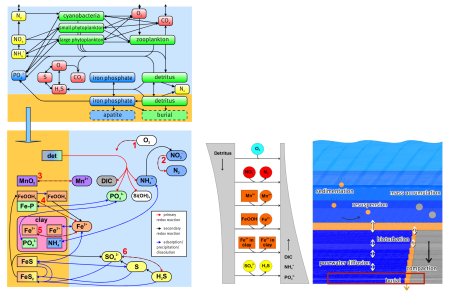
Understanding and quantifying the scope and scale of sedimentary services in the German Baltic Sea (SECOS II)
Eine deutschsprachige Version dieser Seite ist in Arbeit.
For general information please visit the SECOS homepage [1] or the IOW project database [2].
Work Package 2.3. Modelling sediment services under changing environmental conditions and the influence of macrofaunal key species
The task of work package 2.3 was to model important processes at the sediment-water-interface and in the sediment which are indicative of the retention and long term fate of nutrients. These include:
- sedimentation rates of organic material,
- oxygen, nitrogen, phosphorus, and carbon fluxes at the sediment-water-interface,
- transformation of eutrophic substances into non-reactive forms, e.g. nitrate removal via denitrification,
- burial of nitrogen and phosphorus compounds in deep sediment layers.
To do this, the Ecological ReGional Ocean Model (ERGOM) was extended to include vertically resolved sediment biogeochemistry (ERGOM SED 1.0) [3,4].
The extended coupled benthic and pelagic diagenetic model includes:
- continuation of the water column model ERGOM into the pore water of the sediments,
- vertically resolved representation of the upper sediment layers (~22cm)
- non-local bio-diffusion in 1D
- realistic representation of the sediment processes, similar to Reed et al. [2011], iron and manganese oxides, iron monosulfide, pyrite, adsorption of solutes to clay minerals, predictive calculation of pore water pH
Abbildung 1: Biogeochemische und physikalische Prozesse am Sediment-Wasser-Interface und involvierte Zustandsgrößen im erweiterten ERGOM-SED (Quelle: Hagen Radtke, IOW).
All model simulations for SECOS were performed on High Performance Computing (HPC) clusters of the HLRN (North-German Supercomputing Alliance) [5].
An example of the annual mean modelled oxygen fluxes into the sediment is shown below. The fluxes are highest in the vicinity of the coast, where eutrophication also is highest. In contrast, they are lower in central basins, which contain larger amounts of organic material. White areas indicate regions where the substrate is characterized by rocky seafloor, hence, no biogeochemical processes are activated.
A detailed evaluation of the model results is ongoing.
Abbildung 2: Sauerstofffluss ins Sediment [mmol m-2 d-1]. Saisonale Mittelwerte von 1991 bis 1999. Weiße Regionen, die kein Land sind, haben einen felsigen Meeresboden für den keine biogeochemischen Prozesse aktiviert sind (Quelle: Bronwyn Cahill, IOW).
Links and references:
- SECOS Homepage: secos.deutsche-kuestenforschung.de/projekt-secos-synthese.html
- SECOS Beschreibung in IOW Projektdatenbank: www.io-warnemuende.de/project/141/secos_ii.html
- ERGOM homepage: ergom.net/
- Radtke, Hagen, et al. "Ecological ReGional Ocean Model with vertically resolved sediments (ERGOM SED 1.0): Coupling benthic and pelagic biogeochemistry of the south-western Baltic Sea." Geosci. Model Dev. (2019): 275-320. doi: 10.5194/gmd-12-275-2019
- SECOS Rechenzeitprojekt, Norddeutsche Verbund für Hoch- und Höchstleistungsrechnen (HLRN, Projekt ID: mvk00035): zulassung.hlrn.de/kurzbeschreibungen/mvk00035.pdf
Model experiments performed within SECOS
Content only available in English.
Table of Content
- General Information
- Purpose of the Experiments
- Area and time coverage
- Specific information
- Derived Publications
- Contact and Questions
- References
General Information
ERGOM was extended by a 3D sediment model in the SECOS project. The extended ERGOM is denoted as ERGOM SED. The new ERGOM SED model has been documented in Geoscientific Model Development (Radtke et al., 2019, doi: 10.5194/gmd-12-275-2019). The default ERGOM is equipped with an one-layer sediment and includes considerably less benthic processes.
Purpose of the Experiments
Forty years of hindcast simulations were performed with the new ERGOM SED and the old ERGOM (with one-layer sediment) in order to evaluate benefits of the extended ERGOM version. The simulations extended from 1961 to 2000. The full model output (including processes) was saved only for the last 11 years (1990-2000) to save disk space.
Additionally, one climate run following the A1B scenario was performed to assess the impact of climate change on sediment processes (100 years reduced output; 20 years full output).
Area and time coverage
- regional model: western Baltic Sea (model ran for the whole Baltic Sea; detailed sediment data and validation only for western Baltic Seat)
- initialisation time: 240 years spin up on lower resolution of 9 n.m. (six iterations of 40-year period 1961-2000)
- first output time stamp, hindcast, reduced output: 31.08.1961
- first output time stamp, hindcast, full output: 01.01.1990
- last output time stamp, hindcast: 31.12.2000
- first output time stamp, scenario A1B, reduced output: 14.02.2001
- first output time stamp, scenario A1B, full output: 01.01.2080
- last output time stamp, scenario A1B: 31.12.2099
Specific information
naming convention
| model run | internal run/folder name |
|---|---|
| hindcast, default ERGOM | 1-3nm_CLM_C20_8 |
| hindcast, ERGOM SED, reduced output | 1-3nm_CLM_C20_5 |
| hindcast, ERGOM SED, full output | 1-3nm_CLM_C20_9 |
| scenario, ERGOM SED, reduced output | 1-3nm_CLM_A1B_1 |
| scenario, ERGOM SED, full output | 1-3nm_CLM_A1B_2 |
Spezific namelist setup
- external requests: Please contact us (see Contact and Questions below).
- internal requests: phywiki.io-warnemuende.de/do/view/Model/SECOS2
Atmospheric forcing and open boundary conditions
- hindcast: CLM C20 forcing
- scenario: CLM coastDat A1B
Known errors and shortcomings and corrections
Please see Radtke et al. (2019, doi: 10.5194/gmd-12-275-2019) or contact Hagen Radtke.
Configuration and code files
- external requests: Please contact us (see Contact and Questions below).
- internal requests: phywiki.io-warnemuende.de/do/view/Model/SECOS2
Output variables
Please see IOW THREDDS server (all variables available there).
Storage of the results
| Place of Storage | Path |
| IOW Storage | /silod4/dneumann/00_permanent_data/published_data/SECOS/online |
| THREDDS, internal | http://thredds.io-warnemuende.de:8080/thredds/secos/catalog_secos.html |
| THREDDS, external | https://thredds-iow.io-warnemuende.de/thredds/projects/secos/catalog_secos.html |
Derived data sets
none
Contact and Questions
Please see the data set description in the IOWMETA database for contact options.

![Sauerstofffluss ins Sediment [mmol m-2 d-1]. Saisonale Mittelwerte von 1991 bis 1999. Weiße Regionen, die kein Land sind, haben einen felsigen Meeresboden für den keine biogeochemischen Prozesse aktiviert sind (Quelle: Bronwyn Cahill, IOW)](assets/images/0/total_o2_flux_crop-40003f54.png)